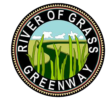Frequently Asked Questions and Myths about the River of Grass Greenway (ROGG)
1. What is the alignment of the ROGG? Will the greenway be on the north or south side of U.S. 41 (Tamiami Trail)? How much distance will separate the greenway from U.S. 41?
Due to environmental concerns, the ROGG will primarily be located within the highway right-of-way. In ROGG-west, the alignment is more likely to be on the south side of US 41. In ROGG-Central, most preferred alignments are in the southern R.O.W. ROGG-East preferred alignments are on the north side of US 41, including the possibility of using the levee bench on the north side of the canal (only if it is consistent with the Everglades Restoration plans).
2. How does the ROGG work for/against Everglades Restoration?
The ROGG will be compatible with Everglades Restoration which is focussed on water flow and water quality. The ROGG (primarily within the right-of-way of US 41) will not impede water flow, nor negatively impact water quality. Every water crossing on US 41 will have a companion water crossing for the ROGG. The ROGG additionally benefits Everglades restoration by providing a platform for education through experience, and fostering stewardship of our Everglades.
3. Will the surface be paved?
Construction material will be determined later. We propose a smooth, hard surface suitable for road bicycles, wheelchairs, roller-blades, etc. Optimal materials must balance many considerations: smoothness of surface, durability/maintenance, cost-effectiveness, minimizing impact to the environment, non-flammable (wildfire-friendly), etc.
4. Myth: ROGG will open up the Everglades to development
US 41 opened up the Everglades to development. That is a done deal. Further opportunities for development are extremely limited, considering that >90% of land adjacent to the ROGG is in public ownership. The remaining lands with private or tribal ownership have already capitalized on economic developments including airboat concessions, restaurants, eco-tour outfitting and campgrounds. Some of these developments may enjoy an economic boost from the ROGG. Everglades City is likely to benefit from increased eco-tourism.
5. Is there a Need for the ROGG?
Currently, it is questionably safe to travel on US 41 within the ROGG route via non-motorized means. This is the only route available for non-motorized travel. The ROGG would provide safe self-propelled travel across the state, and to visit our state and national parks.
The six national and state parks along the ROGG route are experiencing ever increasing vehicle traffic counts. This trend is expected to continue. ROGG, if accompanied by a shuttle system, would actually reduce traffic counts on US 41 and relieve parks of congestion problems and potential trailhead expansions. This is particularly important for Shark Valley visitor center, where overflow parking equates to parking on the shoulder of US 41 (sometimes 50-100 vehicles parked on the shoulder), which creates a safety hazard for visitors and motorists.
The "do nothing" scenario is that the vast majority of Everglades visitors view the Everglades in personal vehicles at 55 mph on US 41. Visitation is increasing, which means more cars. We can expect more cars in the future (more trailhead parking spaces), or we can embrace a 2-lane highway with alternative transportation modes that include non-motorized (bike/ped) modalities combined with transit.
